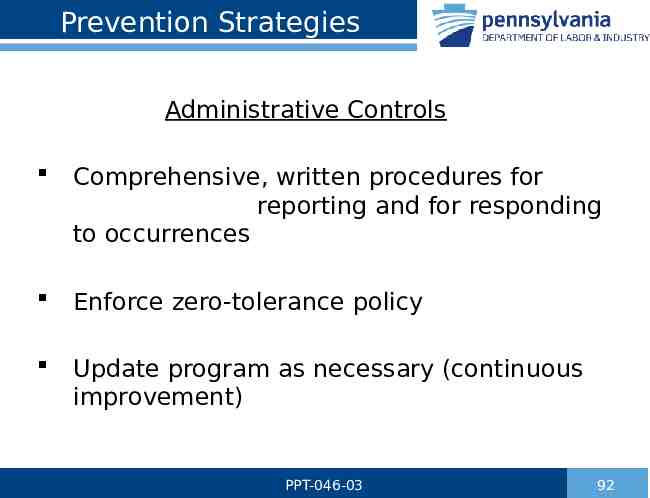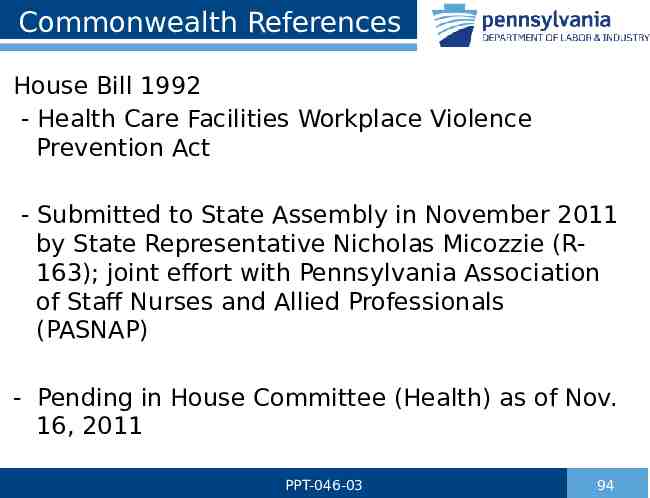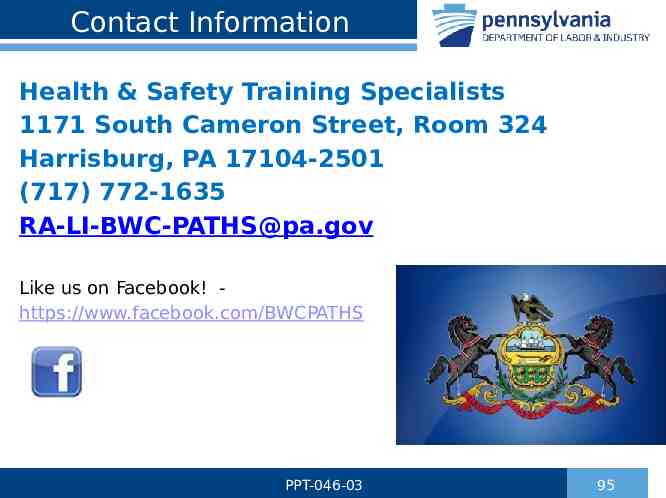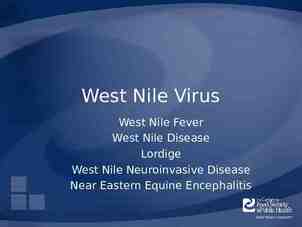Workplace Violence: Healthcare Bureau of Workers’ Compensation
96 Slides3.26 MB
Workplace Violence: Healthcare Bureau of Workers’ Compensation PA Training for Health & Safety (PATHS) PPT-046-03 1
What We’ll Discuss Definition of workplace violence Examples of workplace violence Who is at risk Effects of workplace violence Risk factors Prevention strategies What to do PPT-046-03 2
Workplace Violence Defined “A violent act (or acts) including physical assaults or threats of assaults directed towards a person at work or while on duty” - CDC/NIOSH, Occupational Hazards in Hospitals, 2002 PPT-046-03 3
Facts More than 18 million health care workers today are at high risk to experience workplace violence (80 percent are women) - CDC National Institute for Occupational Safety and Health (NIOSH) Of all non-fatal and violent acts that occurred in the workplace, about 70 percent occurred in the health care and social assistance industry - Bureau of Labor Statistics, 2010 PPT-046-03 4
Workplace Violence: Examples Threats – intent to cause physical harm Verbal (in person or by telephone) Written (by letter, by fax or by telephone) PPT-046-03 5
More Examples Intimidation/Harassment: Psychological – Making statements that are: False Disrespectful Malicious Abusive Disparaging Obnoxious Derogatory Insubordinate Rude Intended to hurt reputation of another PPT-046-03 6
More Examples Intimidation/Harassment Physical Holding Impeding Blocking one’s movement Following Stalking Touching Any other inappropriate contact/advances PPT-046-03 7
Examples Assault – causing physical or emotional injury, pain or distress Hitting, slapping, punching, pushing, poking and kicking Also shouting, name calling, use of derogatory language May include use of a firearm, bomb or knife PPT-046-03 8
Who Is At Risk? In general, anyone who works in a hospital or health care setting (nursing home, assisted living, health clinic, etc.) Specifically, nurses and aides with the most direct contact with patients, during: Meal time Visiting hours Patient transportation Administering care, including bathing PPT-046-03 9
Who Is At Risk? Others at risk include: Emergency response personnel (police, fire, ambulance, volunteers) Hospital safety/security officers Other health care providers PPT-046-03 10
Where it Occurs Waiting rooms Emergency rooms Psychiatric wards Patient rooms Geriatric units Outside facility (parking lots) PPT-046-03 11
Types of Workplace Violence Stranger violence – has no business relationship with the workplace PPT-046-03 12
Types of Workplace Violence Client/Customer violence – recipient of, providing a service to the workplace PPT-046-03 or 13
Types of Workplace Violence Employee violence – related to the workplace (may also be ex-employee or associate of an employee) PPT-046-03 14
Types of Workplace Violence Domestic violence – related to employee (family member, spouse, or partner, significant other) PPT-046-03 15
Examples of Workplace Violence Threats – intent to cause physical harm - Verbal (in person or by telephone) PPT-046-03 16
Examples of Workplace Violence Threats Written (by letter, by fax, or by e-mail) PPT-046-03 17
Examples of Workplace Violence Intimidation/Harassment-Physical Holding Impeding Blocking one’s movement Following Stalking Touching Bullying Any other inappropriate contact or advances PPT-046-03 18
Examples of Workplace Violence Assault – causing physical or emotional injury, pain, or distress: Hitting, slapping, punching, pushing, poking, and kicking PPT-046-03 19
Examples of Workplace Violence Assaults Also shouting, name-calling, use of derogatory language May include use of a firearm, bomb, or knife PPT-046-03 20
Direct Effects of Violence Minor or major physical injuries Temporary or permanent physical disability Psychological trauma Death PPT-046-03 21
Indirect Effects of Violence Low worker morale Increase in job stress Increase in worker turnover Reduced trust of management/co-workers A hostile work environment PPT-046-03 22
Risk Factors Working with volatile people (e.g., those who are under the influence of alcohol/drugs, have a history of violence or are diagnosed as psychotic) Working when understaffed/working alone Transporting patients Long waits for service Overcrowded waiting rooms Poorly-lit areas (parking lots, corridors) Inadequate security Unrestricted movement of the public PPT-046-03 23
Understanding the Angry Person The Angry Person - Rules for Dealing with the Angry Public - Profile of Affected Population Components of Anger Life Change Units Social Changes and High Tech Active Listening PPT-046-03 24
The Angry Person Displays a disruption of balance; an intrusive situation occurs in a person’s life to which they cannot react or stabilize or one to which they refuse to react Is unable to rectify or remedy the situation which they feel they did not create or author themselves; they become angry If this disruption is not properly addressed, if anger results, it may trigger revenge in the extreme PPT-046-03 25
Angry People People feel threatened by: 1. Manipulation; 2. Erosion of their self-esteem; 3. Life changes; 4. Challenges to their security. PPT-046-03 26
Angry People What makes you angry and why? How do you handle your anger? PPT-043-03 27
Profile of Affected Population 1. 2. 3. 4. Age Mind Set Awareness and Perception Physical & Mental Needs PPT-046-03 28
Age Children Adults Elderly Differences in the way anger is caused and handled may be a generational thing. Boomers: 1946-1964 Gen X: 1965-1979 Gen Y: 1980-2000 PPT-046-03 29
Age Present workforce Born The Veterans 1922-1945 Baby Boomers 1946-1964 Generation X 1965-1979 Generation Y – Millennials 1980-2000 PPT-046-03 30
Generational Considerations Present workforce Born The Veterans 1922-1945 Baby Boomers 1946-1964 Generation X 1965-1979 Generation Y – Millennials 1980-2000 PPT-046-03 31
Generational Considerations Generational Dislikes: WWII Generation: Profanity, slang, poor grammar, disrespect Baby Boom Generation: Brusqueness, one-upsmanship Generation X: Using time poorly, corporate-speak Millennial Generation: Cynicism, sarcasm, condescension* *Phyllis Cohn, Project Manager, AARP, “The Aging Workforce: Moving Forward in New Age,” (Turn-offs), OSHA Small Business Forum, July, 2009. PPT-046-03 a 32
Generational Differences in: 1. 2. 3. 4. 5. 6. 7. 8. Philosophy Reasoning Tolerance Judgment Aptitude Spirituality Morality Work Ethics PPT-046-03 33
Mind Sets Altruistic Egotistical Messianic Questioning Spiteful Arguer Detached Complaining Belligerent Introverted Extroverted Uncooperative Retreating Phobic PPT-046-03 34
Awareness & Perception Of a problem and its remedy is determined by a person’s: Education; Training; Experience; Lack of information or interest; Technical Barriers to Understanding; Nonconformity; Political or personal agendas. PPT-046-03 35
Physical & Mental Needs Dependencies interfering with understanding and Factors impacting mental health: Weight; Family Health; Rising Prices; Full schedules; Misplacing/losing things; Outside yard/home maintenance; Property, investments & taxes; Crime; Personal/physical appearance. PPT-046-03 36
Components of Anger Like the “3 mirror images of Self” 1. How the complainant views the situation 2. How you view the situation 3. What the situation really is PPT-046-03 37
Life Change Units Established from studies conducted by Dr. T. H. Holmes and Dr. R. H. Rahe Addresses changes to a person’s life within the last 24 months. Values assigned may provide an indication whether a person may incur an illness in the next year if not properly handled. PPT-046-03 38
Life Change Units Areas considered to impact a person and health risks assigned include the areas of: Work Events; Personal Issues; Financial State; Social Condition; Family Concerns. PPT-046-03 39
Social Changes & High Tech “Doublespeak Quiz” “Technological changes and their new terminology may confound, confuse and anger those required to work with these systems” PPT-046-03 40
Types of Complaints Types of complaints from the angry public may be directed at: Products; Services; Individuals within your organization; Company performance overall or specifically. These could be based on a lack of understanding of your operation or false presumptions. (The public’s perception and expectations). PPT-046-03 41
The Eternal Victim Mystique Profile “Always pitiful and always in the middle of a crisis for all kinds of complicated reasons, which you’ll feel compelled to explore and try to fix, if you aren’t careful.” PPT-046-03 42
The Eternal Victim Mystique Profile They hold others “hostage” Not responsible Everyone’s out to get them Not my fault . . . It’s everyone else’s fault PPT-046-03 43
Handling Anger 4 Principles for Dealing with People 1. Build trust and rapport - eliminate the threat; 2. Determine and meet the person’s needs; 3. Communicate on all levels Read the cues - verbal, visual, tones; 4. Solve the problem. PPT-046-03 44
Handling Anger 1. Assess the Anger - Determine the level Low: normal tone/pitch; little/no swearing; context (is it anger?). Moderate: higher pitch; swearing; crying; gesturing; face flushed. High: sustained high pitch (voice cracking); personalized vulgarity; “fingerpainting”; repeating basic concept; stammering. PPT-046-03 45
Handling Anger 2. Assess your reaction: (Pro-active or Reactive) Realize your abilities/limitations; Cope; Assert appropriate assertiveness; Don’t talk yourself into a corner; Relax on cue; Fog (agree with any truth, probability of or general truth). PPT-046-03 46
Handling Anger 3. Calm the anger through: Active Listening; Allowing the person to “vent”; Sectoring anger toward true (real) cause; Reflecting; Asking/answering questions PPT-046-03 47
Handling Anger 4. Solve the problem Keep people feeling good about themselves. Objectives: Get them off defensive; Reflect their concern, do not immediately answer complaint; Discover reasons behind their problem; Involve person in finding a solution. PPT-046-03 48
Handling Anger Types of Questions: What in particular troubles you? What specifically do you feel we need to correct? What stands in the way? How do you feel our past performance was better? What do you think is the first step in resolving this problem? PPT-046-03 49
Handling Anger Other Goals: Provide acceptable alternatives; Empathize: see the situation from their perspective; Dovetail: resolution summary of event showing how alternative solutions merge with demands or requests; Your agency is a facilitator to remedy problems! PPT-046-03 50
Dealing with Angry Public Strategies: 1. The communications process; 2. Listening/speaking skills; 3. Telephone techniques; 4. Knowing your people; 5. Administrative policies & procedures. PPT-046-03 51
1. The Communication Process PPT-046-03 52
Communications Process Sender Message/ Medium Receiver Experience Verbal/nonExperience Attitudes written Attitudes Skills Email Skills Perceptions Web Perceptions Pictures PPT-046-03 53
Communications Process Input Feedback Personality/Style View of others/self Behavior Communication skills feedback Climate Complainant’s How well you handle PPT-046-03 54
Communications Process Coping abilities or Your predetermined outcome: defensiveness - Lose/Lose - Lose/Win (Altruistic. Reasonable?) - Win/Win (Optimum result) - Win/Lose (Temporary Victory) Result may be perpetual HalloweenYou’ll see this ‘ghost’ again. PPT-046-03 55
Anger Vocabulary Mild Moderate Strong Intense Moody Unhappy Very Unhappy Bitter Concerned Discontented Frustrated Angry Disappointed Disturbed Fed Up Disgusted Worried Sullen Indignant Outraged Dissatisfied Troubled Irate Furious Some words, by their very construct, may sound harsh (hard and soft sounds) PPT-046-03 56
Phrasing Questions Open Questions Phrased so they can NOT be answered simply with yes or no Begin With What Who When Where How Which Closed Question (Avoid) Phrased so they can be answered by a yes or no reply Begin With Is Can Do Will Has Shall PPT-046-03 57
2. Listening/Speaking Skills Effective Listening; Active Listening; Persuasion; Types of Responses and their Result. PPT-046-03 58
Effective Listening Listening is 1/3 of communication Listen for ideas-not facts; Judge content (first); not delivery (secondary); Be an optimistic listener, from the beginning; Listen to the full message-don’t jump to conclusions; Be flexible-take notes; Concentrate on the speaker. PPT-046-03 59
Effective Listening Thought: 4 x faster than speech. Analyze message Read verbal/non-verbal signs - Posture, head positioning - Eye movement and contact - Hands - Proximity (territorial aspect) Standing/sitting/lounging Gestures Word choice and pace of speech Tonality and intensity - Facial expressions PPT-046-03 60
Effective Listening Work at Listening: Provide feedback; Keep open mind: don’t fall victim to “trigger” words or emotions; heed central theme of message; Stretch your mind by experiencing new information, not just that with which you’re familiar. PPT-046-03 61
Active Listening Defined: Paying careful attention to content & feelings of message. Content: What words mean and context of use. Feeling: Emotions displayed by content. Feelings real as disclosed? Are true feelings masked? PPT-046-03 62
Active Listening Before you reply: Attempt to determine core theme; Determine content and feeling; Consider what you heard; Ask for clarification & feedback; Reflect before replying; Understand speaker’s position, then construct your conclusion and reply. PPT-046-03 63
Active Listening Personal Approach and Attitudes Realize there is a nobility inherent in people, each has value and a contribution; Express care and concern; Realize all are unique and different; Express empathy. What we view as trivial might be their most significant concern. PPT-046-03 64
Active Listening Components Encouraging Restating Reflecting Summarizing PPT-046-03 65
Active Listening Components 1. Encouraging Goal: Project interest; maintain conversation. Process: Be non-committal; don’t agree or disagree; use positive tone of voice. Listener’s comments: “I see ” “Uh-huh” “That’s interesting ” PPT-046-03 66
Active Listening Components 2. Restating Goal: Shows your understanding; discloses grasp of facts. Process: Restate speaker’s basic ideas; place emphasis on facts. Listener’s comments: “If I understand, your idea is ” “In other words, you think ” PPT-046-03 67
Active Listening Components 3. Reflecting Goal: Demonstrates you’re listening and understanding; lets speaker know you understand how they feel. Process: Reflect person’s feelings with short replies without being flippant or curt. Listener’s comments: “You feel that ” “You were pretty annoyed by this ” PPT-046-03 68
Active Listening Components 4. Summarizing Goal: Draw together ideas and facts; create basis for continued discussion; review/update progress. Process: Major ideas are restated, reflected and summarized. Listener’s comments: “These seem to be the main ideas you’ve expressed ” “If I understand you, you feel this way about ” PPT-046-03 69
Reflection and Fogging Reflection A restatement, (not a question) of: What you understand; The speaker said; Expressed in your own words; Including your understanding of contents and feelings revealed. Solutions are not reached at this level. This stage seeks to ensure agreement on the topic between parties. PPT-046-03 70
Reflection Your Approach: Be non-judgmental; Be non-argumentative; Do not evaluate; Do not question; Repeat your understanding; Encourage person to continue. PPT-046-03 71
Reflection Your Goal Check your understanding of speaker’s statements; Promote continued dialog; Improve empathetic listening; Build rapport; Display your caring, and; Demonstrate your understanding. PPT-046-03 72
Reflection and Fogging Reflection Levels (5): Repeating word-for-word; Repeating but changing I to You; Repeating part of the conversation but not summarizing; Summarizing in your own words; Summarizing content and feeling of message; Example: “I can truly understand why this has you (feeling) particularly due to (content) .” PPT-2016-GOSH 73
Fogging Fogging: Method of reply used when you’re under attack or criticism. It’s simply agreeing with -Any truth -The probability of truth, or -The general truth or agreeing in principle Comment: “You never give me a good job evaluation. You don’t even know my capabilities.” Fogged Reply: “You’re probably right, I should get to know your capabilities better.” PPT-046-03 74
Persuasion Requires: Listening Skills Empathy Disarming Inquiry Self-Expression Skills Stroking Tactful Presentation Problem-Solving PPT-046-03 75
Persuasion Listening Skills Empathy: Attentive listening to feelings. Reflect back in sympathetic, non-judgmental way. Disarming: Find the core truth, even if it seems to be distorted or illogical. Inquiry: Question to change vague points into the real issues. PPT-046-03 76
Persuasion Self-Expression Skills Stroking: Be positive. Compliment and reward people. Tactful Presentation: Express your thinking and feeling in objective, constructive manner. Problem-Solving: Resolve real problems after above techniques are used now that core truth and reasons are identified. PPT-046-03 77
Persuasion General Persuasion Techniques: Use home-turf advantage; Look your best; Identify with your listener; Reflect the listener’s experience; Make a strong case; Employ stories and examples PPT-046-03 78
Substance Abuse Substance abuse can also contribute to workplace violence! Many times people who are normally calm and cooperative can become angry and violent while under the influence or drugs or alcohol. PPT-046-03 79
The Unseen Reality Think PA’s workplaces are drug free? Think again. 75% of drug users are employed Almost one in ten employees has a substance abuse problem 24% of workers admit to drinking during the workday at least once in the past year 15% of U.S. workers report using alcohol or being impaired on the job in the past year PPT-046-03 80
The Cost of Substance Abuse Increased Health Care Costs Increased Workers’ Compensation Premiums Increased Workplace Violence PPT-046-03 81
Substance Abuse Individuals who abuse drugs or alcohol are three and a half times more likely to be involved in a workplace accident compared to individuals who do not abuse drugs or alcohol 47% of industrial injuries are directly related to alcohol abuse or alcoholism PPT-046-03 82
Drug-Free Workplace Policy Accomplishes two major things: 1. Sends a clear message that use of alcohol and drugs in the workplace is prohibited 2. Encourages employees who have problems with alcohol and other drugs to voluntarily seek help PPT-046-03 83
Violence-Signals Verbally expressed anger or frustration Body language/threatening gestures Signs of alcohol or drug use Presence of a weapon (firearm, knife, etc.) PPT-046-03 84
What to Do Present a calm, caring attitude Don’t match the threat Don’t give orders Acknowledge what the person feels Avoid aggressive behavior PPT-046-03 85
What Else Evaluate each situation Be vigilant Do not isolate yourself Always keep an open path for exiting PPT-046-03 86
Unable to Defuse? Remove yourself from the situation Call security for help Report any violent situations to management For someone with a weapon: Stay calm - Maintain eye contact Stall for time Keep talking.but follow instructions of the person with the weapon Don’t risk harm to yourself or others Never try to be a hero or try to grab a weapon Watch for an opportunity to escape safely PPT-046-03 87
Violence Prevention Develop a comprehensive prevention program that includes: Zero tolerance policy Management commitment/enforcement Employee participation Hazard identification Training Hazard prevention Accurate and timely reporting PPT-046-03 88
Prevention Strategies Engineering Including installation of: Emergency alarms Signaling and monitoring systems Security devices (metal detectors, cameras) Better lighting Enclosed nurses’ stations Bullet-proof/shatter-proof glass enclosures at reception areas PPT-046-03 89
Prevention Strategies Changing Behavior Create “buddy system” Provide security escorts to parking lots Prevent personnel from working alone Restrict movement of public using controlledaccess cards PPT-046-03 90
Prevention Strategies Changing Behavior Training in hazard awareness, resolving conflicts, recognizing potential signs Make counseling available to reduce workers’ fear Have open communication with workers PPT-046-03 91
Prevention Strategies Administrative Controls Comprehensive, written procedures for reporting and for responding to occurrences Enforce zero-tolerance policy Update program as necessary (continuous improvement) PPT-046-03 92
References OSHA 3148 – Guidelines for Preventing Workplace Violence for Health Care and Social Service Workers (2004) www.osha.gov CDC/NIOSH – Workplace Violence – Healthcare Workers www.cdc.gov https://www.osha.gov/SLTC/healthcarefacilities/ violence.html PPT-046-03 93
Commonwealth References House Bill 1992 - Health Care Facilities Workplace Violence Prevention Act - Submitted to State Assembly in November 2011 by State Representative Nicholas Micozzie (R163); joint effort with Pennsylvania Association of Staff Nurses and Allied Professionals (PASNAP) - Pending in House Committee (Health) as of Nov. 16, 2011 PPT-046-03 94
Contact Information Health & Safety Training Specialists 1171 South Cameron Street, Room 324 Harrisburg, PA 17104-2501 (717) 772-1635 [email protected] Like us on Facebook! https://www.facebook.com/BWCPATHS PPT-046-03 95
Questions PPT-046-03 96





































































































